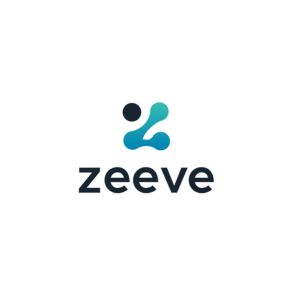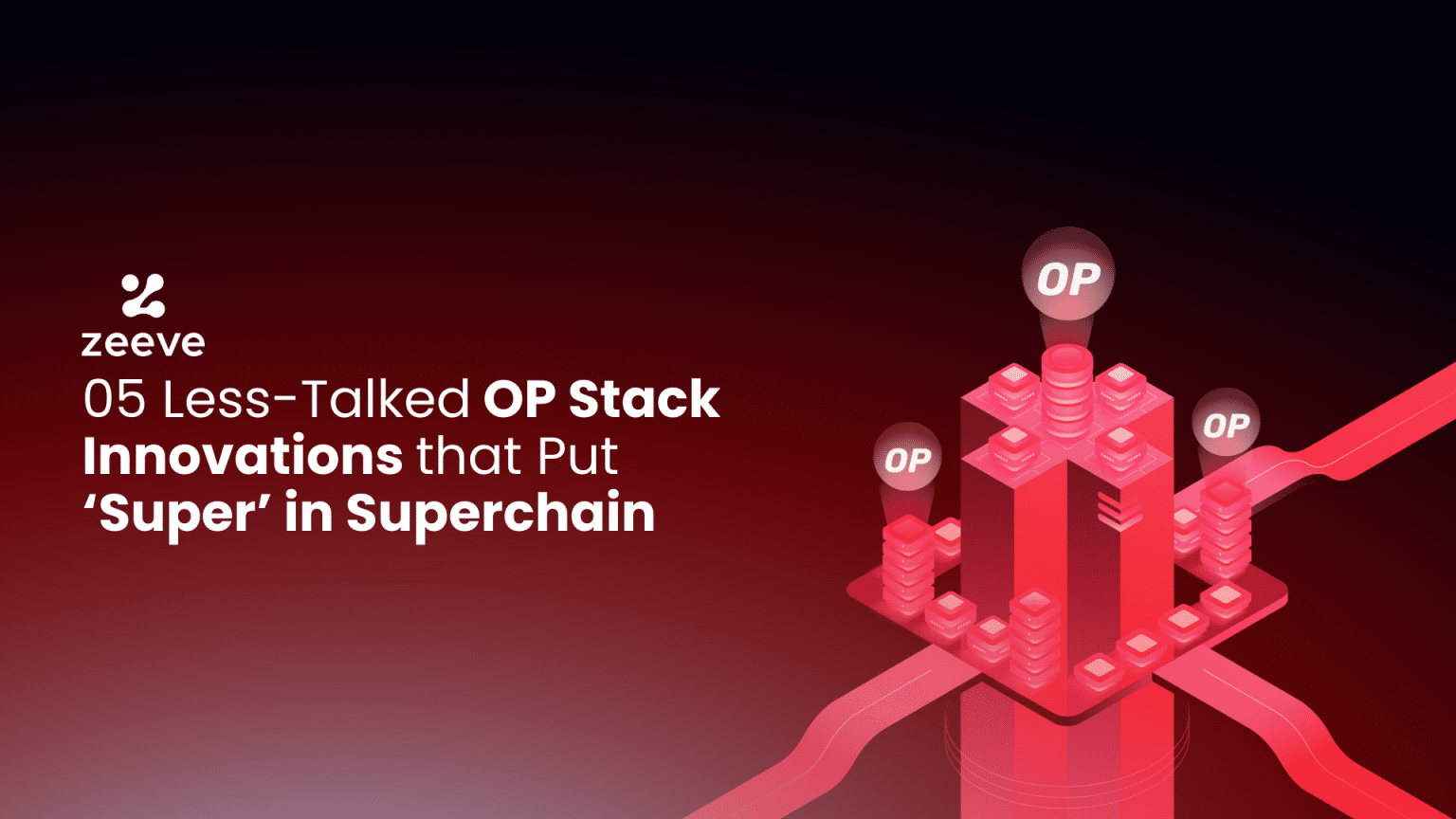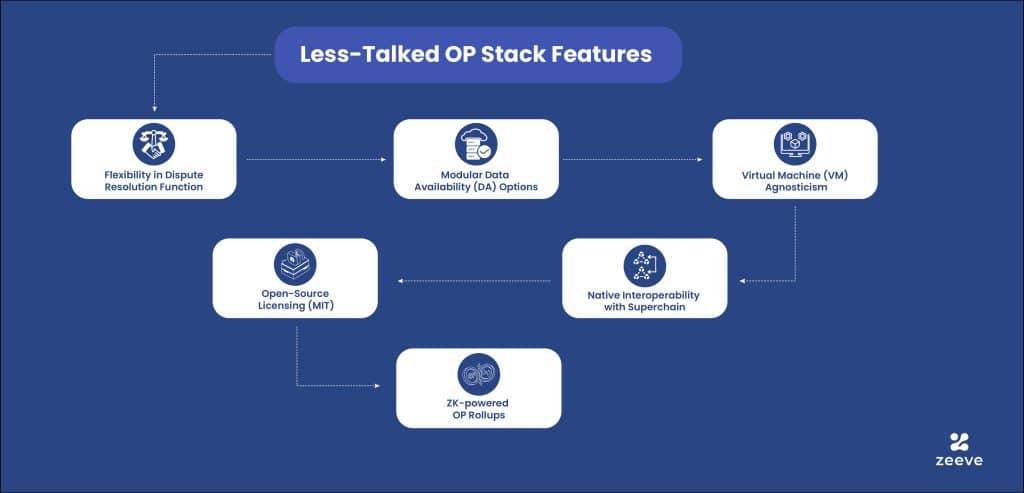05 Less-Talked OP Stack Features that Put ‘Super’ in Superchain
 Zeeve
Zeeve
OP Stack Layer2 chains are the most integral component of Superchain ecosystem that accounts for around 46% of its total transactions coming from 42 OP chains (testnet and mainnet). This has been possible because OP Stack is recognized as the most-matured and ready Layer2 rollup stack across the vast developer community and in the whole web3 ecosystem. Despite this, people are not fully aware of OP Stack’s true capabilities, which actually come from some of its lesser-known features.
Through this article, we will discuss the top-five OP Stack innovations that are powering the ‘super’ factor in the Superchain, allowing for the creation of Layer2 rollup chains for the future. Each of these features is designed to accelerate the OP Stack option and thus contribute to the growth of the entire Superchain ecosystem.
06 Less-talked OP Stack features taking Superchain adoption to next-level
Let’s talk about some of the highly feasible yet lesser-known features of OP Stack. These are designed to make OP Stack a lot more innovative and powerful to match custom L2 requirements. You may already know that OP Chains are the main contributor to the Superchain expansion. Any growth in the number of OP chains leads to direct expansion of Superchain. By Superchain, we mean the entire network of Layer2 OP chains and applications launching on the Superchain ecosystem. All these networks share a common security layer, communication layer, and an open-source stack:
1. Flexible dispute resolution function (OP and ZK):
Dispute resolution is the most vital process in verifying the output roots and ensuring its correctness. In a standard rollup setup, dispute resolution is mainly supported either for optimistic or zero-knowledge mechanisms. However, for OP Stack, it doesn’t matter if a Layer2 chain leverages optimistic, zero-knowledge, or a unique mechanism because OP Stack supports all types of dispute resolution functions while also allowing for custom finality time matching Layer2’s unique withdrawal requirements.
In case you are wondering how dispute resolution works in OP and ZK rollups, here’s a simple breakdown:
In the OP Stack chain, the op-challenger serves as a honest actor through the fault dispute process. When one side of the ‘FaultDisputeGame’s timer runs out, it becomes the responsibility of the honest validator to resolve each of the claims through calling the resolveClaim function. Once the subgame for the root claim is resolved, the op-challenger calls out the resolve function to close all the open points of disagreement, in case left.
Speaking about ZK rollups, these doesn’t implement a challenge period as transactions are validated instantly using cryptographic proofs and mathematical algorithms. However, if there’s a dispute or the validity of the transactions is questioned, the underlying main chain can revert to the on-chain state to resolve the conflicts efficiently.
2. Modular DA (data availability) options, not limited to Ethereum:
Leading players in alt-DA or alternative data availability solutions like Celestia, Avail, NearDA, and Avail has proven the unique benefits as well as efficiency of modular DA layers. OP Stack realized the importance of modular DA long back, hence it allows developers to modify DA layer module of a OP Stack chain.
DA options on OP Stack include both the off-chain DA layers (discussed above), alternative EVM DA, EVM-ordered Alternative DA, Non-EVM DA, and multi-DA modules. Learn about these DA layers here.
However, like most rollups, the default DA layer on OP Stack is Ethereum. When using Ethereum as a DA module, all the data, such as call data, events, and block information, are available on Ethereum and can be queried easily.
3. Complete VM agnosticism (outside EVM) for dispute resolution:
Similar to DA layers, OP Stack has also been optimized for VM agnosticism. OP stack initially had its dispute resolution dependency entirely on the EVM. This means if a user submits a challenge, the corresponding queued transactions had to run through EVM. While this approach is simple, quicker, and secure– its the on-chain mechanism of dispute resolution felt a little costly for the majority of Layer2s.
Now OP Stack builders do not need to use EVM, and they can support the VM of their choice with a custom dispute resolution function. This allows flexibility for Layer2 rollups to build according to unique computational requirements or those optimized for a specific virtual machine. For example, OP Stack can use Optimistic Virtual Machine (OVM), Fault Proof Virtual Machine (FPVM)- Cannon and Asteric, Risc Zero zkEVM, etc.
4. Native cross-chain interoperability and stage 2 decentralization:
Layer2s opting for Superchain construct will have access to native interoperability and stage 2 decentralization by default.
As we know, interoperability refers to blockchain’s ability to read state of a different blockchain. OP Stack’s native interoperability provides Layer2 chains the ability to seamlessly transfer assets and read messages across the Superchain ecosystem without the need to go through the underlying Layer1. This interoperability happens via low-latency and secure message passing, which offers the following main benefits:
1-block latency asset movement is an approach to capital-efficieny and non-framenting movements of asset across different chains.
Enhanced user experience for Layer2 developers building on the Superchain ecosystem.
Secure and seamless transfer of ERC-20 tokens and ETH across Later2s.
Support development of applications that achieve horizontal scaling to offer high throughput, speed, and performance.
OP Stack is moving aggressively toward reaching Stage 2 decentralization. Once it’s live, any Layre2 with Superchain can get default support for Stage-2 decentralization. This Stage-2 decentralization is critical. It elevates interoperability and removes any changes of censorship. That’s because Stage 2 ensures that no group of actors (not even unanimously) can post a state root except the code output. This is a major improvement in Stage 1, which involves a multisig version that may alter the chain’s state to cause censorship or invalid withdrawals.
5. Open-source MIT licensesing for 100% permissionless adoption:
As one of most permissive open-source licenses, MIT really sets OP Stack apart while also complimenting its key features like Ethereum equivalence, modular proof systems, and multi-chain accessibility, fast deposit times, and more. Here’s key details of MIT licensing:
MIT is the most leanest license.
With MIT, OP Stack offers ‘Do whatever you want with the stack, just don’t sure me’.
It’s a fully permissible and free license.
MIT allows for rapid adoption, allowing frameworks like OP Stack to eliminate the fear of not getting enough coverage for their product.
MIT Licensing allows OP Stack to serve as a public good, enabling Layer2s to easily swap different OP Stack components and add new capabilities through clear-cut interfaces and versioning schemes. This allows for a maximum degree of flexibility to the OP Stack architecture to ensure it can easily adapt to all the future developments of the Ethereum ecosystem, plus developers can innovate, modify, and deploy Layer2s without any legal or licensing barriers.
Developers worldwide can now use OP Stack-based testnet to experiment and run tests, or they can modify the chain to suit their use case-specific needs. With The Stack’s free and open-source MIT software, anyone can modify or launch the stack in any configuration they want.

6. Support for Zk-Enabled OP Rollups:
Another latest and crucial upgrade on OP Stack is the support for development of OP Stack rollups integrated with ZK capabilities. This means, any chain can now use zero knowledge or ZK-verified blocks while other OP Stack components like op-geth, op-node, and op-batcher remain unchanged. Through this process, OP Stack chains can be easily upgraded to zkEVM rollup to leverage the following main benefits:
Fast confirmation with ZK proofs: OP rollups with ZK capabilities reduces the delay in confirmation, replacing the 7-days challenge window to mere minutes of confirmation.
Cost reduction: Average transaction cost in ZK-enabled OP rollups are reduced significantly, requiring just a few cents.
Swiping OP Stack to ZK: Through integration of ZK-fied rollups services, Layer2s can switch from OP stack to ZK proofs, thereby generating ZK proofs easily via API calls.
OP Stack Compatibility: ZK-fied OP stack rollups are 100% compatible with all the OP Stack tools, smart contracts, and services.
Enhanced scalability: Zk-enabled OP rollups are designed to be highly customizable to add unique precompiles or modify the rollup logic based on custom requirements.
OP Succinct, Risc Zero’s zkEVM, and O (1) labs are the key services enabling the creation of ZK-fied OP rollups at the moment.
If you want to dive deeper into ZK-fied OP Rollups, refer to this article:
ZK-fied OP Rollups: Forging the Base of ZK Future on Superchain
Leverage Exclusive OP Stack Features for your Laye2s: Build with Zeeve RaaS
Popularity around OP Stack is not just intact, but it’s increasing constantly due to popular projects like Base, Worldcoin, and opBNB already thriving on it. A lot of new projects, including from leading organizations, emerging startups, and indie solutions, are now planning their transition to OP Stack chains. At this stage, Zeeve RaaS is assisting Layer2 chains with top-level infrastructure management, modular chain development, configurations (3rd party rollup service integrations), and 24/7 infra monitoring & maintenance. All these allow for rapid-fast and low-cost launch of Layer2 chains; be it for mainnet or testnet. Btw, you can setup a full-fledged OP Stack Chain’s testnet with all the configurations and customizations. The, our experts will move your testnet quickly to the mainnet. Try Zeeve RaaS’ OP Stack sandbox here.
Also, for any queries, confusion, or suggestions, you can send us an email or schedule a call for a detailed discussion. We’re happy to assist you!
Subscribe to my newsletter
Read articles from Zeeve directly inside your inbox. Subscribe to the newsletter, and don't miss out.
Written by

Zeeve
Zeeve
Zeeve is an enterprise-grade low-code Blockchain Infrastructure-as-a-Service platform, compliant with ISO 27001, SOC2 Type II, and GDPR standards. We are the leading provider of Rollups-as-a-Service, dedicated node infrastructure, and hosted subgraphs. All the infrastructure managed by Zeeve includes 24x7 monitoring, Enterprise SLA, 99.9% uptime guarantee, and management dashboards to ensure a secure and scalable infrastructure. With support for all major Blockchains, 27,000+ platform users, and 40+ enterprise clients, Zeeve stands tall as the global go-to provider for Web3 infrastructure.
